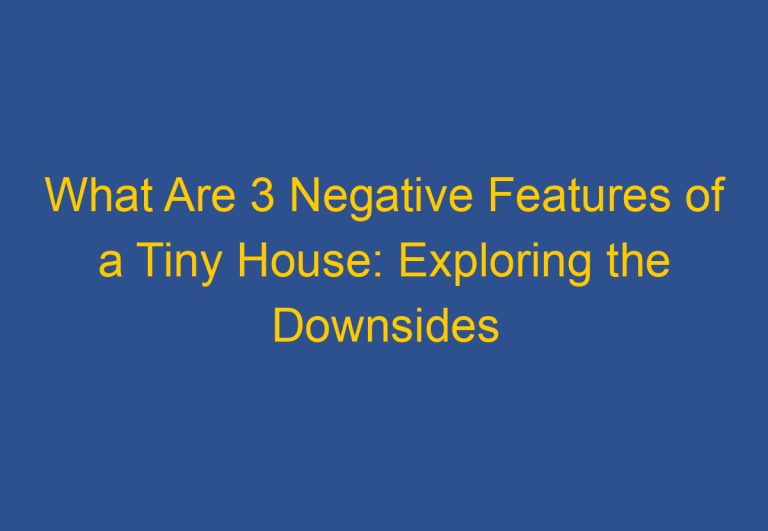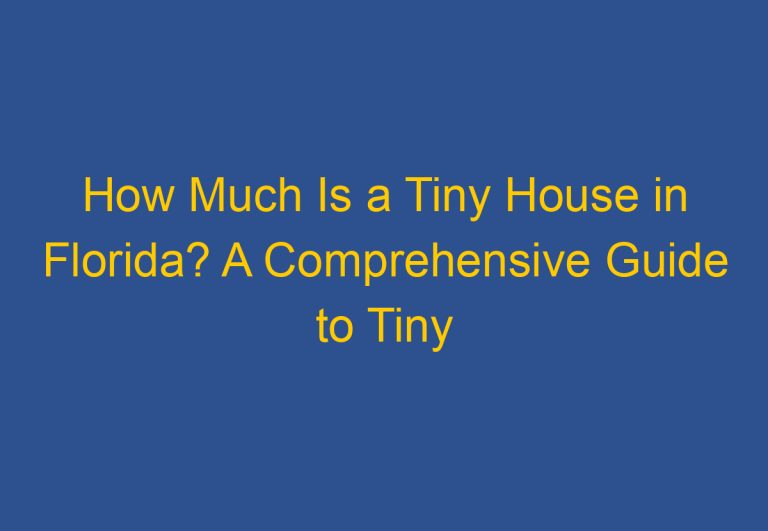Are Tiny Houses Legal in Los Angeles? Exploring the Regulations and Requirements
Tiny houses have been gaining popularity in recent years as a way to live a minimalist lifestyle and reduce living expenses. However, many people wonder if tiny houses are legal in Los Angeles. The answer is not straightforward and depends on several factors, including zoning laws and building codes.
According to Appendix Q, several counties in California, including Los Angeles, allow tiny houses as accessory dwelling units (ADUs). These ADUs need to meet specific requirements and regulations to be considered legal. Additionally, tiny houses on wheels are also allowed in all zoning districts in San Diego.
It is important to note that although tiny houses are allowed in some areas of Los Angeles, they must comply with local rules and regulations. Therefore, it is crucial to check with the county’s planning department and obtain the necessary permits before building or living in a tiny house.
Legality and Zoning Laws
Understanding Zoning and Ordinances
Before delving into the legality of tiny houses in Los Angeles, it is essential to understand zoning and ordinances. Zoning is the process of dividing land into specific zones or areas to regulate land use. The zoning ordinance is a set of laws that govern land use, including building size, location, and type.
Los Angeles ADU Regulations
In 2019, Los Angeles passed the LA 2019-12-5 ADU Ordinance R19-0408, which allows for the construction of Accessory Dwelling Units (ADUs) in single-family and multi-family zones. ADUs are a type of tiny house that is built on the same lot as a primary residence.
Under the new ordinance, ADUs can be up to 1,200 square feet for a one-bedroom unit and up to 1,500 square feet for a two-bedroom unit. However, the size of the ADU cannot exceed 50% of the primary residence’s size.
Permits and Building Codes
To build an ADU in Los Angeles, one must obtain a permit from the Department of Building and Safety. The permit process includes submitting plans, paying fees, and obtaining inspections.
Additionally, all ADUs must comply with the California Building Code, which sets standards for construction, electrical, plumbing, and mechanical systems. Failure to comply with building codes and permit requirements can result in fines and legal action.
It is essential to note that not all tiny houses are ADUs, and not all ADUs are tiny houses. While tiny houses on wheels (THOWs) are not considered ADUs in Los Angeles, they may be permitted as an RV or a mobile home.
In conclusion, while zoning laws and ordinances can be complex, understanding them is crucial for anyone interested in building a tiny house in Los Angeles. By following the regulations and obtaining the necessary permits, building a tiny house in Los Angeles can be a viable option for those seeking an affordable and sustainable living solution.
Tiny House Living in California
Tiny houses have been gaining popularity in California as a potential solution to the state’s housing crisis. In Los Angeles, tiny houses are now legal as accessory dwelling units (ADUs) thanks to years of advocacy and legal developments.
Types of Tiny Houses in LA
There are different types of tiny houses in Los Angeles, including movable tiny houses, THOWs (tiny homes on wheels), and co-built homes. These homes can be built on a chassis with axles, contain 400 sq feet or less of gross floor area, and are considered an RV, CC or PT.
Advocacy and Legal Developments
Advocacy groups such as the Tiny Home Industry Association and the American Tiny House Association have been instrumental in pushing for legal recognition of tiny houses as a viable alternative to traditional housing. In 2016, the California Department of Housing and Community Development issued guidelines for tiny homes sold, rented, leased or occupied within the state. These guidelines require tiny homes to meet certain standards, including size and safety requirements.
Community and Lifestyle
Tiny house living offers a unique lifestyle that emphasizes simplicity, sustainability, and community. Tiny home communities in California have been popping up in recent years, offering affordable housing options for those looking to downsize or live more sustainably. These communities often feature shared amenities such as gardens, community kitchens, and social spaces.
In conclusion, while tiny houses are not a panacea for California’s housing crisis, they offer a promising alternative to traditional housing options. With legal recognition and growing advocacy, tiny house living may become a more viable and accessible option for those looking for affordable and sustainable housing.
Frequently Asked Questions
What is the maximum allowable size for a tiny house in California?
In California, the maximum allowable size for a tiny house varies depending on the local zoning and building codes. Some areas may have specific requirements for minimum square footage, while others restrict where tiny houses are parked. However, in Los Angeles, tiny houses are allowed as accessory dwelling units (ADUs), provided they meet certain size and setback requirements.
Are there specific zoning regulations for tiny houses in Los Angeles County?
Yes, there are specific zoning regulations for tiny houses in Los Angeles County. Tiny houses on wheels (THOWs) are permitted in all zoning districts, as long as they comply with the California Building Code and the Los Angeles Municipal Code (LAMC) Section 12.22A.33. This section of the LAMC includes local development standards and requirements for ADUs, Junior Accessory Dwelling Units (JADUs), and Movable Tiny Houses (MTHs) in Government Code (GC) Sections 65852.2 and 65852.22.
What permits are required to build a tiny house in Los Angeles?
To build a tiny house in Los Angeles, you will need to obtain the necessary permits from the Los Angeles Department of Building and Safety (LADBS). The permits required will depend on the type of tiny house you are building and the location where it will be built. It is recommended that you consult with a licensed contractor or architect to ensure that you comply with all the necessary regulations and requirements.
Can tiny houses be used as accessory dwelling units (ADUs) in Los Angeles?
Yes, tiny houses can be used as accessory dwelling units (ADUs) in Los Angeles, provided they meet certain size and setback requirements. The ADU Ordinance (Ord. No. 186,481) was adopted on December 11, 2019, and became effective on December 19, 2019. It added Los Angeles Municipal Code (LAMC) Section 12.22A.33, which includes local development standards and requirements for ADUs, Junior Accessory Dwelling Units (JADUs), and Movable Tiny Houses (MTHs) in Government Code (GC) Sections 65852.2 and 65852.22.
How does the cost of building a tiny house in Los Angeles compare to traditional housing?
The cost of building a tiny house in Los Angeles can vary widely depending on the size, materials, and design of the house. However, in general, building a tiny house can be more affordable than building a traditional house. The cost of a tiny house can range from $10,000 to $100,000 or more, depending on the level of customization and materials used. It is recommended that you consult with a licensed contractor or architect to get an accurate estimate of the cost of building a tiny house in Los Angeles.
What are the regulations for establishing a tiny home village in Los Angeles?
The regulations for establishing a tiny home village in Los Angeles are complex and vary depending on the location and zoning regulations. However, in general, establishing a tiny home village in Los Angeles would require compliance with all the necessary zoning and building codes, as well as obtaining the necessary permits from the Los Angeles Department of Building and Safety (LADBS). It is recommended that you consult with a licensed contractor or architect to ensure that you comply with all the necessary regulations and requirements.










